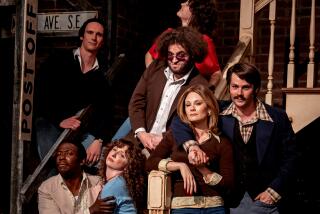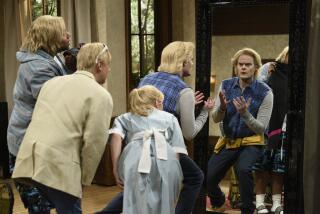Sahl is the wicked wit of the West
- Share via
HEARING that Mort Sahl had turned 80 was the social equivalent of realizing that one’s high school sweetheart was now a grandmother.
It forced an abrupt acceptance of passing years and, in Sahl’s case, of a passing era when we were young and loud and demanding of a better, smarter world.
In the long run we didn’t get either, but the 1960s was at least a time of coming to grips with our shortcomings, and Sahl was there to point them out.
He was the cultural warrior in a clip of time that began with the Eisenhower presidency and ended, more or less, with the assassination of John F. Kennedy. It embraced a moment in history when Sahl was leading a parade out of a San Francisco club called the hungry i that eventually trailed across the nation.
I see him as a postgraduate out of USC in a red, V-neck sweater, a rolled up newspaper under one arm, rattling off a combination of jokes with the speed of a Gatling gun, rarely missing his target. An admirer dubbed him “a rebel without a pause.”
Even his laugh was a staccato, and his grin a combination of pleasure and grimace, not unlike the smile on the face of a tiger.
The point of all this is we are at last honoring Sahl as an American icon, more than just a kid telling jokes way back then when we were all hip enough to dig what he was saying and counting on him to say it.
Two events are occurring to recognize the man’s contribution not only to humor and satire but also to being the first to stand up and point a finger in the face of those whose hypocrisies were justifying war and racial suppression.
Sahl created the era that blossomed to include the genius of Tom Lehrer, Shelley Berman, Woody Allen, Dick Gregory, Mike Nichols and Elaine May and a lot of others who played the hungry i, a small club tucked into a corner of North Beach that was home to a generation of cognoscenti.
I said that two events are occurring to acknowledge Sahl’s contributions. One is a June 28 tribute in Westwood’s Wadsworth Theater, where comedy notables such as Bill Maher, Robin Williams and Jay Leno are expected to appear. The other is contained in an announcement that Sahl will teach a course in critical thinking twice a week beginning in September at Claremont McKenna College in Claremont.
OK, so it’s important to gather a lot of celebrities to honor a guy who used to refer to Eisenhower as “one of our presidents, according to many” and to then Vice President Nixon as being born in a log cabin in a blue serge suit. But it’s even more important to tap into the brain of a man who probably knows more about critical thinking than most of his successors ever will.
Sahl’s ride up to this point hasn’t been an easy one. He’s been in and out of fashion more times than long dresses, part of which was due to his endorsement of a conspiracy theory in the Kennedy assassination. Like Gregory during the civil rights movement, Sahl got serious about his newfound mission and the laughter died.
While celebrated in smaller venues and enjoying a revival of sorts now and again, he never did make it back to where he was, but that wasn’t entirely his fault. The times that had created him had ended, and his attack-dog style of humor just didn’t seem funny anymore.
San Francisco Chronicle columnist Herb Caen called him “the light that failed,” and critics were quick to point out that Sahl was a used-to-be. To my own regret, I too took a bite out of the guy I had known since the hungry i days, failing to realize that he was more than just a part of one era but had joined other great satirists whose influence has endured beyond their lifetimes. Sahl was my generation’s “Will Rogers with fangs,” as one writer dubbed him. Another said, “He didn’t tell jokes. He told truths.”
He made the cover of Time magazine in 1960 and, more recently, Comedy Central has put him at No. 40 on a list of the 100 greatest stand-up comedians of all time. And now there’s that tribute in June, and Sahl lecturing on critical thinking to a bunch of kids to whom the 1960s are about as remote as the Roaring ‘20s. Sahl can tell them what it was like back when truth was unpatriotic and critical thinking was a crime. It still applies. The country hasn’t changed much.
Sahl said it better. I see him leaning toward an audience. The rolled-up newspaper. The expectant grin. Then: “Two hundred years ago we had Jefferson, Washington, Ben Franklin and Tom Paine, and there were 4 million people. Today we have 220 million and look at our leaders. Darwin was wrong.”
Zap.
Al Martinez’s column appears Monday and Friday. He can be reached at al.martinez@latimes.com.






